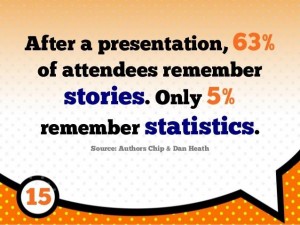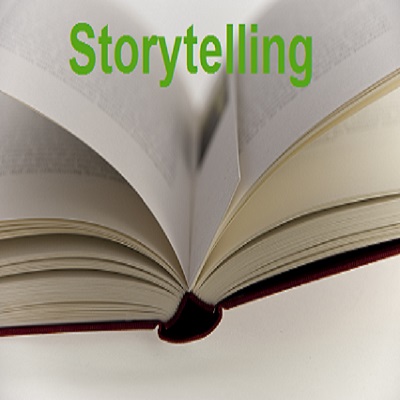Storytelling in training is nothing new.
Since time began generations have been telling and retelling stories through families, passing on traditions, cultures and family values. The retelling of these stories helps embed these values to the next generation so that these stories continue to be told for generations to come. Stories when told well, help to form our ideas and perceptions. Stories have the power to change our hearts and our minds. When we connect with a story we sometimes get a physical reaction. We get chills up our spine, our hearts race, we laugh, we cry and we can even feel sick to our stomach. We can also change. We can think, behave and feel differently after experiencing a powerful story. One that we connect with emotionally. One that has the power to change both our hearts and our minds. Using storytelling in training is an extremely useful technique to transfer learning to the audience.  The definition of learning is that the learner has changed. What they’ve been exposed to during the training program has caused them to think, behave and/or feel differently. In fact, if your learner remains the same at the end of the training program as they were at the beginning then they haven’t actually learnt at all. So what makes a good story? One that can keep people engaged during the telling and that is retained, recalled and retold.
The definition of learning is that the learner has changed. What they’ve been exposed to during the training program has caused them to think, behave and/or feel differently. In fact, if your learner remains the same at the end of the training program as they were at the beginning then they haven’t actually learnt at all. So what makes a good story? One that can keep people engaged during the telling and that is retained, recalled and retold.
The 5 elements of an effective story structure
- Â Firstly it needs to have a beginning, middle and an end.
- There’s a main character. Someone who is ordinary, likeable and relatable to your learners. It could even be one of the learners or a learner from a past session or even the trainer when they were in the learner’s position. It needs to be one of them.
- This main character then faces a challenge, a problem, or an event that creates an obstacle that they need to overcome. They have a desire for something better. Â It needs to be clear to your learners that this reality is too difficult to continue.
   Amplify the gap between what the current reality is and what it could be.
   A future that’s desirable for the main character as well as your learners.
- The main character then struggles making the decision on what they need to do to make things better. They may resist it at first but then start searching for answers. They research, ask other people, try out some different strategies until coming across the solution.
 This is where the concepts and techniques that you’re delivering come in.
- The main character then uses these concepts and/or techniques. They make the change and even though there may be some bumps in the road over time the changes settle in and the initial challenges, problems and desires have been resolved.
   The competencies (knowledge, skills, attitudes) that they learnt allowed them to achieve their something better.
The main character has transformed
 Combining a good story structure with effective communication and delivery skills creates an emotional connection with the learner who now desires something better. You are the facilitator of that something better. You help people move from their current state into a different one where they engage with the learning and hold onto it because they want that new experience.
That something better.
Continuously referring to and incorporating the story throughout the learning program helps to refocus your learner on the big picture and the outcome of the learning. As a facilitator of change, seeing my learners transformed as a result of my learning programs rewards me immensely. It’s the thing that still inspires me to do what I do after over 20 years in this industry. This has allowed me to have a variety of stories in my collection that help me change the hearts and minds of people. Customising your story along with the training content needs to meet the needs of the learner.
Design your customised learning solution by visiting: Create your Customised Learning Solution
What stories have you told or heard that have changed you?




[…] How storytelling in training changes people. 5 elements of an effective story. | Training x Design […]
Thanks so much for your response Christopher. Its great hearing how other people use stories.
There is also fascinating neuroscience behind it, how stories change brain chemistry thereby changing people. See it here: http://www.spring.org.uk/2014/01/the-psychology-of-storytelling-and-empathy-animated.php?utm_content=buffer05c59&utm_medium=social&utm_source=twitter.com&utm_campaign=buffer
Great article Gina,
Reinforces a concept that I’ve always held to during presentations. Your break down into the 5 elements is a great planning tool. I often instruct in technical concepts and having real life stories to relate to gives more relevance for the learner and softens some of the ‘dryer’ topics.
I’ll certainly use these tips in my next training.
Many Thanks
Thanks for your comment Neil. Glad to hear about other people using stories in training
Hi Gina
CONGRATULATIONS..!!!
On a great article which I’ve been talking about in leadership training over the last year and on a great website.
There’s great stuff here and you should be proud of this achievement.
Hope to see you again soon.
Thanks for your comment Martyn. I hope to see you again soon too.
Thanks Gina…..I stumbled over the power of stories in some lectures. Sensing the audience loosing interest or tiring, using a story is a great way to reconnect and stir enthusiasm. I have quite a few stories that I can ‘pull out’ when needed to reinvigorate the discussion. Now, by simply say…..let me tell you a story…. the audience leans forward and re-engages. Not to mention, they repeat it later in other contexts, so I am pretty sure it has made an impression.
Great to hear
Isn’t that the best feeling Jenny! To know that you’ve connected with your audience